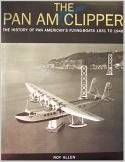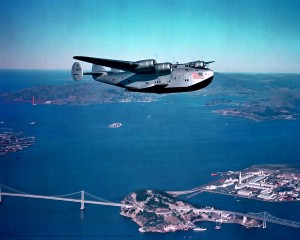 We here at WoWasis have all see those pictures of those magnificent flying boats leaving to Hawaii, the Golden Gate Bridge or the Bay Bridge in the background. And we wondered: what was it like to fly in them? What services were offered? How much did a flight cost? Can we still see them in aviation museums? Roy Allen’s remarkable book The PanAm Clipper: The History of Pan American’s Flying Boats 1931 to 1946 (2000, ISBN 0-7607-2187-4) answers all those questions and more. It’s a fascinating read.
We here at WoWasis have all see those pictures of those magnificent flying boats leaving to Hawaii, the Golden Gate Bridge or the Bay Bridge in the background. And we wondered: what was it like to fly in them? What services were offered? How much did a flight cost? Can we still see them in aviation museums? Roy Allen’s remarkable book The PanAm Clipper: The History of Pan American’s Flying Boats 1931 to 1946 (2000, ISBN 0-7607-2187-4) answers all those questions and more. It’s a fascinating read.
The story is centered around Pan American Airways founder Juan Trippe and his desire to offer air travel options from the United States to Hawaii and the Pacific, Latin America, and Europe. He was the innovator, utilizing such craft as the Sikorsky S-42, Martin M-130, and the iconic Boeing 314, among others. The book has wonderful photos of all these, as well as other aircraft in his fleet. Allen gets behind the scenes to describe the pluses and minuses of each aircraft and the reasons for the decisions Trippe made to evolve to more powerful airplanes. He also describes Trippe’s challenges in dealing with governments, plane manufacturers, and even his own board of directors.

A PanAm Boeing 314 clipper over San Francisco Bay
The first PanAm Clipper to reach Hawaii, an S-42, arrived in 1935, essentially a test flight. The trip took 18 hours. But Trippe needed a larger craft, which came with the Martin M-130, carrying 8-10 passengers in three compartments, with a dining and cocktail lounge, formal evening meals, and Pullman berths. Trippe’s idea was to create an ocean liner in the sky, but the Martin’s overhead engines created enough compartment noise that he realized that changes were in order. The solution came with the legendary Boeing 314, which arrived in the PanAm fleet in 1938.
The 314 was the largest passenger airplane in the world at the time, carrying 74 passengers and a crew of 10. Among its innovations were proper toilets for men and women (waste was discharged over the ocean), 65 windows, a full-service galley, and a bar. The upholstery was fireproofed and there were ten life rafts. It made its inaugural passenger flight in 1939.
By now, Trippe had added fueling stops in Guam and Wake Island in order to add the Philippines to his destination list. The 314 was also flying European and Latin American routes as well. The advent of World War II closed PanAm’s passenger routes in Europe, and with the war in the Pacific beginning in the aftermath of Pearl Harbor, all of Trippe’s 314s were either sold to the British military or requisitioned by U.S. forces.
By the end of the war, the concept of passenger air travel changed. The building of military landing strips throughout the Pacific ushered in land-based aircraft, and the days of the transoceanic flying boat were over.
So where can you see PanAm’s Sikorsky S-42, Martin M-130, and the Boeing 314 today? You can’t. They’ve all been used for parts, scrapped, demolished, or were destroyed while being deployed. The last 314 was scrapped in 1951, a victim of changing technology. These beautiful airships, representative of the romance of early trans-ocenic passenger travel, are all gone, except for what you’ll find in postcards and books like Roy Allen’s.
The book’s a good one, 112 pages in large format, with a great story and lots of wonderful photos. There is one nit-pick. In photos, the Golden Gate Bridge is identified as the San Francisco Bay Bridge, and vise-versa. How could Allen and his editor have missed that?
Nevertheless, the book is worth reading and keeping, especially for those who have a whimsical fancy for long-lost romantic, exotic, and luxurious air travel, words that most certainly can’t be used to describe trans-oceanic air travel today.
[…] air travel killed Matson’s Hawaiian passenger business. And in similar fashion to the outcome of Pan American’s amphibious Boeing B314 Clipper airplanes, those richly appointed Matson steamers have all been destroyed. No one even bothered to […]